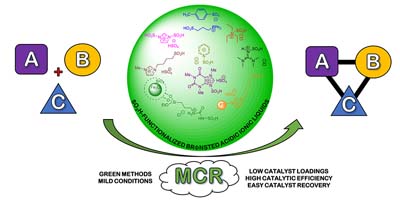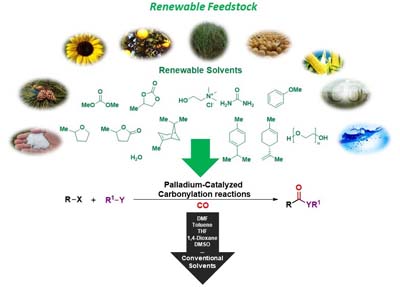vol. 33, No. 7, 2022, p. 609-799
The concept of sustainable development was placed in focus about 35 years ago and described as the "development that meets the needs of the present without compromising the ability of future generations to meet their own needs". Hence, sustainability is a paradigm for thinking about the future, in which improvements in quality of life are pursued through an equilibrated mix of environmental, economic and societal considerations.
Inspired by UNESCO's initiative to highlight the connection between Basic Sciences and the Sustainable Development Goals, the Journal of the Brazilian Chemical Society is proud of publishing a special edition centered on the subject "2022-International Year of Basic Sciences for the Sustainable Development". This special edition contains review papers and original contributions related to "Greener synthesis and analysis" and "Environmental chemistry and biorefining", two main aspects of Chemistry within the scope of the JBCS.
The contributions have been submitted by different research groups. Considering that the initiative of producing this special issue met with high success and was enthusiastically welcomed by the chemical community, and that this has resulted in an important number of received submissions, the originally proposed aim to release a single volume has been modified and articles have now been thematically grouped in two special issues (33-7 and 33-8). Therefore, the Editorial Board of the JBCS wishes to thank all authors for considering our invitation and joining us in this endeavor.
Chemistry for Sustainable Development
Editorial J. Braz. Chem. Soc. 2022, 33(7), 609
Chemistry for Sustainable Development
Luiz Pereira Ramos  ; Teodoro S. Kaufman
; Teodoro S. Kaufman
https://dx.doi.org/10.21577/0103-5053.20220070
Review J. Braz. Chem. Soc. 2022, 33(7), 610-636
Sustainable and Reusable Sulfonic Acid-Functionalized Task-Specific Ionic Liquid Catalysts for Multicomponent Reactions. A Review
Nicolas S. dos Anjos  ; Luiz S. Longo Jr.
; Luiz S. Longo Jr.

In this review contribution we discuss the use of sulfonic acid-functionalized task-specific ionic liquids as sustainable and reusable catalysts for multicomponent reactions applied to the synthesis of heterocycles and related compounds.
https://dx.doi.org/10.21577/0103-5053.20220021
J. Braz. Chem. Soc. 2022, 33(7), 637-663
Recent Developments on Palladium-Catalyzed Carbonylation Reactions in Renewable Solvents
Danilo Y. de Albuquerque; Wystan K. O. Teixeira; Senthil Narayanaperumal; Ricardo S. Schwab

The solvents derived from renewable raw materials can be used as an alternative green media for palladium-catalyzed carbonylation reactions, offering a promising and alternative way to construct a wide array of organic molecules carrying a carbon-oxygen double bond.
https://dx.doi.org/10.21577/0103-5053.20220024
J. Braz. Chem. Soc. 2022, 33(7), 664-680
Sustainable Synthetic Strategies for the Preparation of Low Molecular Weight Drugs by Biotech Routes
Patricia G. Ferreira  ; Alcione S. de Carvalho
; Alcione S. de Carvalho  ; Wilson C. Santos
; Wilson C. Santos  ; Luana S. M. Forezi
; Luana S. M. Forezi  ; Fernando C. da Silva
; Fernando C. da Silva  ;
;
Vitor F. Ferreira

This review intends to show how the challenges for the production of some low molecular weight drugs produced by synthetic routes that involve at least one biotechnological step using microorganisms or enzymes were faced.
https://dx.doi.org/10.21577/0103-5053.20220044
J. Braz. Chem. Soc. 2022, 33(7), 681-692
Internet of Things as a Tool for Sustainable Analytical Chemistry: A Review
Alegre N. S. Cadeado; Caio C. S. Machado; Geandre C. Oliveira  ; Daniela A. S e Silva; Rodrigo A. A. Muñoz
; Daniela A. S e Silva; Rodrigo A. A. Muñoz  ; Sidnei G. Silva
; Sidnei G. Silva

Internet of things (IoT) can play key role to attend the sustainable development goals. The association of IoT with analytical chemistry enables the real-time analytes monitoring, that assess impacts of human activities on environmental and human health.
https://dx.doi.org/10.21577/0103-5053.20220048
Articles J. Braz. Chem. Soc. 2022, 33(7), 639-700
A Green Analytical Method Using Polyurethane Foam for The Extraction and Determination of Lauryl Ether Sulfate in Personal Care Hygiene Products
Felipe R. Müzel; Eduardo L. Rossini  ; Helena R. Pezza
; Helena R. Pezza

A green analytical method using polyurethane foam and methylene blue was developed for the extraction and determination of lauryl ether sulfate in personal care hygiene products employing spectrophotometric and digital image detections.
https://dx.doi.org/10.21577/0103-5053.20210170
J. Braz. Chem. Soc. 2022, 33(7), 701-714
Anti-Zika Virus Effects, Placenta Protection and Chemical Composition of Passiflora edulis Seeds Ethanolic Extract
Jadriane A. Xavier  ; Jaqueline C. Santos; Monique A. Vila Nova; Camilla M. Gonçalves; Karen S. C. Borbely
; Jaqueline C. Santos; Monique A. Vila Nova; Camilla M. Gonçalves; Karen S. C. Borbely  ; Keyla S. N. Pires; Flávia A. R. dos Santos
; Keyla S. N. Pires; Flávia A. R. dos Santos  ; Iara B. Valentim
; Iara B. Valentim  ; Júnia H. P. Barbosa; Felipe C. da Silva; Josué C. C. Santos
; Júnia H. P. Barbosa; Felipe C. da Silva; Josué C. C. Santos  ; Danielle R. Pinho; Norberto P. Lopes
; Danielle R. Pinho; Norberto P. Lopes  ; Alexandre U. Borbely
; Alexandre U. Borbely  ; Marília O. F. Goulart
; Marília O. F. Goulart

The passion fruit seed ethanol extract presents a plethora of bioactive compounds, consistently reduced the viral load of the two Zika virus (ZIKV) strains (MR766 and PE243) and cellular NS1 expression of trophoblastic cells.
https://dx.doi.org/10.21577/0103-5053.20220003
J. Braz. Chem. Soc. 2022, 33(7), 715-724
Supercritical Carbon Dioxide Effect on Lipase-Catalyzed Geranyl Acetate Synthesis
Matheus V. L. Tavares; Luís R. S. Kanda  ; Wanderson R. Giacomin Júnior; Luiz P. Ramos; Luciana P. S. Vandenberghe; Marcos L. Corazza
; Wanderson R. Giacomin Júnior; Luiz P. Ramos; Luciana P. S. Vandenberghe; Marcos L. Corazza

Geranyl acetate was synthesized using acetic acid, in the presence of enzymes and using different solvents and reactor types.
https://dx.doi.org/10.21577/0103-5053.20220008
J. Braz. Chem. Soc. 2022, 33(7), 725-733
Tuning the Photocatalytic Activity of Tin Oxide through Mechanical Surface Activation
Fernando B. F. Silva; Gelson T. S. T. da Silva  ; Juliana A. Torres; Caue Ribeiro
; Juliana A. Torres; Caue Ribeiro

SnO2 nanoparticles are activated by the high-energy ball milling process and enhance their photocatalytic activity to degrade rhodamine B.
https://dx.doi.org/10.21577/0103-5053.20220009
J. Braz. Chem. Soc. 2022, 33(7), 734-742
Unveiling the Bacterial Sesquiterpenome of Streptomyces sp. CBMAI 2042 Discloses Cyclases with Versatile Performances
Douglas C. Sachito  ; Luciana G. de Oliveira
; Luciana G. de Oliveira

Mining encoding sesquiterpene synthase genes in Streptomyces CBMAI 2042 reveals versatile enzymes promoting cyclization in terpenes biosynthesis.
https://dx.doi.org/10.21577/0103-5053.20220013
J. Braz. Chem. Soc. 2022, 33(7), 743-752
Boosting the Photocurrent of the WO3/BiVO4 Heterojunction by Photoelectrodeposition of the Oxy-Hydroxide-Phosphates Based on Co, Fe, or Ni
Dyovani Coelho  ; João Pedro R. S. Gaudêncio; Lucia H. Mascaro
; João Pedro R. S. Gaudêncio; Lucia H. Mascaro

The photoelectrodeposition of oxy-hydroxide-phosphates based on Co, Fe, or Ni was performed on WO3/BiVO4 heterojunction to produce photoanodes more efficient to the water oxidation under solar simulate light. The best catalyst increased 2.83 times the photocurrent compared to the non-modified heterojunction.
https://dx.doi.org/10.21577/0103-5053.20220015
J. Braz. Chem. Soc. 2022, 33(7), 753-761
Additive Manufacturing towards the Fabrication of Greener Electrochemical Sensors for Antioxidants
Nélio I. G. Inoque; Lucas V. de Faria; Rodrigo A. A. Muñoz

Additively-manufactured carbon-black-integrated polylactic acid sensor for antioxidant sensing: application to pyrogallol detection in biodiesel.
https://dx.doi.org/10.21577/0103-5053.20220025
J. Braz. Chem. Soc. 2022, 33(7), 762-771
Chemometric Evaluation of Poly(3-hexylthiophene) Electrochemical Aging Path as a Function of Electrochemical Synthesis Variables
Roger Gonçalves  ; Ernesto C. Pereira
; Ernesto C. Pereira

The correlation between the concentrations of the precursors used in the polymer synthesis that will be aged considerably affects the aging path that this sample will undergo. The electrochemical aging of the polymer is caused by the deactivation of parts of the polymer chain that are no longer able to intercalate ions and undergo oxidation/reduction.
https://dx.doi.org/10.21577/0103-5053.20220039
J. Braz. Chem. Soc. 2022, 33(7), 772-782
Valorization of Hesperidin from Citrus Residues: Evaluation of Microwave-Assisted Synthesis of Hesperidin-Mg Complex and Their Insecticidal Activity
Danielle F. da Silva; João P. A. Bomfim; Rafael C. Marchi; Jéssica C. Amaral; Luciano S. Pinto; Rose M. Carlos; Antonio G. Ferreira  ; Moacir R. Forim
; Moacir R. Forim  ; João B. Fernandes; Maria F. G. F. da Silva
; João B. Fernandes; Maria F. G. F. da Silva  ; Regiane C. de Oliveira; David Buss; William D. J. Kirk
; Regiane C. de Oliveira; David Buss; William D. J. Kirk  ; Toby J. A. Bruce
; Toby J. A. Bruce

The microwave synthesis of hesperidin-Mg improves yield. It can be used for Bemisia tabaci and Spodoptera frugiperda management strategy, and for Myzus persicae as repellent.
https://dx.doi.org/10.21577/0103-5053.20220050
J. Braz. Chem. Soc. 2022, 33(7), 783-789
Thermal Infrared Enthalpimetry Method for the Determination of Hypochlorite in Bleaching Solutions
Flavia M. Dalla Nora; Alessandra S. Oliveira; Fabio A. Duarte  ; Alexandre J. Cichoski; Juliano S. Barin
; Alexandre J. Cichoski; Juliano S. Barin

Hypochlorite in bleaching solutions was determined based on the temperature rise from the reaction with a hydrogen peroxide solution. Infrared thermal imaging was used for simultaneous contactless temperature measurements of multiple reactions in a microplate.
https://dx.doi.org/10.21577/0103-5053.20220054
J. Braz. Chem. Soc. 2022, 33(7), 790-799
Simultaneous GC-NCI-MS Determination of Persistent Organic Pollutants and Current-Use Pesticides in Breast Milk Samples
Mariela S. Viera; Giovana Ferronato; Herliana D. F. Abreu; Osmar D. Prestes; Martha B. Adaime; Renato Zanella

A simple method for persistent organic pollutants (POPs) and current-use pesticides (CUPs) determination in breast milk using gas chromatography coupled to mass spectrometry with negative chemical ionization (GC-NCI-MS) was successfully validated and applied to a biomonitoring study.
https://dx.doi.org/10.21577/0103-5053.20220068
Online version ISSN 1678-4790 Printed version ISSN 0103-5053
Journal of the Brazilian Chemical Society
JBCS Editorial and Publishing Office
University of Campinas - UNICAMP
13083-970 Campinas-SP, Brazil
Free access










